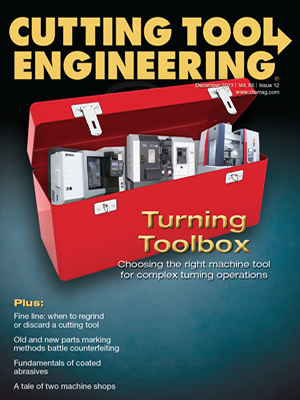Like many in the industry, when I started in the machining world it was on a manual lathe. I have a special place in my heart for lathes. That includes CNC lathes, the next step up for aspiring machinists. In my experience, I have found there is a lopsided ratio of CNC mill machinists to CNC lathe machinists, with about 10 times as many being mill machinists. My theory is this is partly because the CNC lathe is more difficult to operate.
I have heard the argument that the CNC lathe only has two axes and, therefore, can’t be that difficult to use. After all, the mill has at least three axes so it must be more complicated.
But that’s not so. Imagine on a 3-axis mill that every time you do a tool change the entire tool magazine rapid traverses into the work zone. As it does, it approaches the mill table, which is spinning at 4,000 rpm along with the workpiece. The spindle mass of steel is about to shear off all the tools hanging from the magazine. This would be the mill equivalent to the CNC lathe.
Early in the history of CNC mills, a tool holding and changing system was adopted that simplified and helped eliminate the danger of spectacular crashes. In this system, all the tools are held in individual holders, which have a common mounting position and are safely stored well away from the work area. This small factor, I believe, is the major reason why there are so many more CNC mill machinists than CNC lathe machinists; it is so much easier to crash a CNC lathe than a CNC mill because of this basic design difference.
In the standard 2-axis CNC lathe, most of the tools are held stationary in a large turret while a workpiece of unknown size and weight revolves to provide the cutting action. Each tool is indexed and brought into the work area with all its companions mounted in the turret. Also, because most of the tools are stationary, the workholding device, which is a large mass of steel, must spin. This provides another obstacle that you must plan and account for to avoid a crash when operating a CNC lathe.
If machine tool builders had their thinking caps on back in the day, they would have adopted a system similar to the setup used on most CNC mills. Only in modern times, though, do we see a trend, in some CNC lathes, where this kind of system is starting to materialize.
In the job shop environment, a CNC lathe can be either a real moneymaker or time sinker. It’s almost always a tough call whether to set up and run a small lot of parts on a CNC or a manual lathe. CNC lathes are intended for high-volume production and often don’t lend themselves to short runs or lots of changeovers.
So what is the appropriate job size for setting up and running a CNC lathe vs. running one manually? Some of what drives this decision is part geometry and quantity, but more often than not, it’s the setup and programming time. If the CNC lathe was as easy as the manual lathe to set up and program, the threshold job size to justify running a CNC lathe would be reduced. Therefore, it’s important to focus on ways to reduce the amount of setup and programming necessary to get a job out of the starting gate and into the CNC lathe. Keep in mind that the thinking is completely different on a production job, where the setup and programming is amortized over a large number of parts.
The following are some questions to answer when running a small quantity of parts on a CNC lathe.
- Is it likely the job will repeat?
- If it comes back, will it be the same?
- Can we run extra parts and store them for future orders?
- Do we already run a similar part that we can leverage our tooling or setup with?
- Is the part geometry difficult enough to warrant the setup and programming effort?
- Can the operator do secondary operations on the parts while they run unattended in the CNC lathe to telescope the schedule and manpower used?
- Will the customer pay for it?
Answering yes to any of these questions is a good reason to spend the extra effort required to perform the job on a CNC lathe and potentially generate more profits. CTE
About the Author: Tom Lipton is a career metalworker who has worked at various job shops that produce parts for the consumer product development, laboratory equipment, medical services and custom machinery design industries. He has received six U.S. patents and lives in Alamo, Calif. For more information, visit his blog at oxtool.blogspot.com and video channel at www.youtube.com/user/oxtoolco. Lipton’s column is adapted from information in his book “Metalworking Sink or Swim: Tips and Tricks for Machinists, Welders, and Fabricators,” published by Industrial Press Inc., South Norwalk, Conn. The publisher can be reached by calling (888) 528-7852 or visiting www.industrialpress.com. By indicating the code CTE-2013 when ordering, CTE readers will receive a 20 percent discount off the book’s list price of $44.95.Related Glossary Terms
- computer numerical control ( CNC)
computer numerical control ( CNC)
Microprocessor-based controller dedicated to a machine tool that permits the creation or modification of parts. Programmed numerical control activates the machine’s servos and spindle drives and controls the various machining operations. See DNC, direct numerical control; NC, numerical control.
- lathe
lathe
Turning machine capable of sawing, milling, grinding, gear-cutting, drilling, reaming, boring, threading, facing, chamfering, grooving, knurling, spinning, parting, necking, taper-cutting, and cam- and eccentric-cutting, as well as step- and straight-turning. Comes in a variety of forms, ranging from manual to semiautomatic to fully automatic, with major types being engine lathes, turning and contouring lathes, turret lathes and numerical-control lathes. The engine lathe consists of a headstock and spindle, tailstock, bed, carriage (complete with apron) and cross slides. Features include gear- (speed) and feed-selector levers, toolpost, compound rest, lead screw and reversing lead screw, threading dial and rapid-traverse lever. Special lathe types include through-the-spindle, camshaft and crankshaft, brake drum and rotor, spinning and gun-barrel machines. Toolroom and bench lathes are used for precision work; the former for tool-and-die work and similar tasks, the latter for small workpieces (instruments, watches), normally without a power feed. Models are typically designated according to their “swing,” or the largest-diameter workpiece that can be rotated; bed length, or the distance between centers; and horsepower generated. See turning machine.
- milling machine ( mill)
milling machine ( mill)
Runs endmills and arbor-mounted milling cutters. Features include a head with a spindle that drives the cutters; a column, knee and table that provide motion in the three Cartesian axes; and a base that supports the components and houses the cutting-fluid pump and reservoir. The work is mounted on the table and fed into the rotating cutter or endmill to accomplish the milling steps; vertical milling machines also feed endmills into the work by means of a spindle-mounted quill. Models range from small manual machines to big bed-type and duplex mills. All take one of three basic forms: vertical, horizontal or convertible horizontal/vertical. Vertical machines may be knee-type (the table is mounted on a knee that can be elevated) or bed-type (the table is securely supported and only moves horizontally). In general, horizontal machines are bigger and more powerful, while vertical machines are lighter but more versatile and easier to set up and operate.


